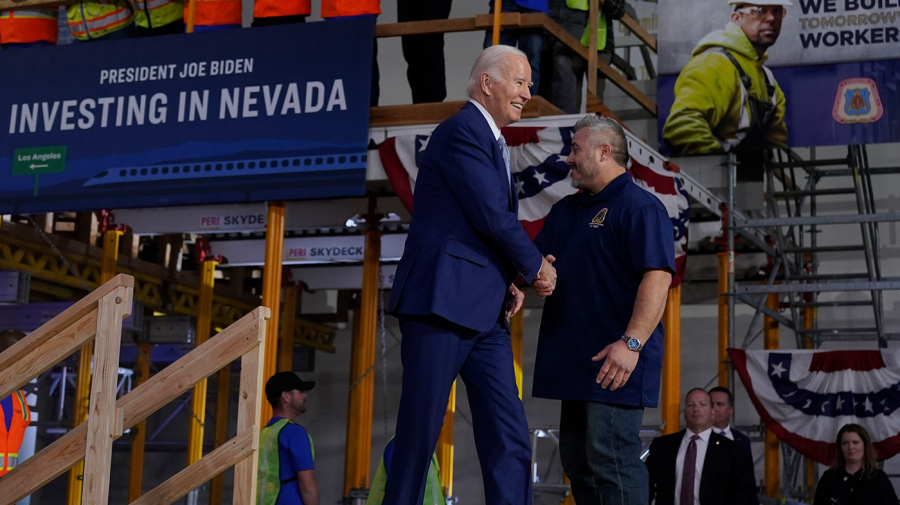Passenger trains could help combat climate change — if rail can actually get built

The Biden administration is investing billions in passenger rail, giving a boost to a potentially important tool for mitigating climate change.
However, significant hurdles could slow efforts to get more rail online.
Last week, President Biden announced $8.2 billion in Bipartisan Infrastructure Law funding for 10 passenger rail projects, including what the White House described as the “first world-class high-speed rail projects in our country’s history.”
The funded projects include a line connecting California to Las Vegas — which alone is expected to carry 11 million passengers each year and prevent 400,000 tons of carbon dioxide from entering the atmosphere — as well as lines serving California’s Central Valley, North Carolina and a line connecting Washington, D.C., and Richmond, Va.
Experts, the rail industry and environmentalists say that passenger trains could be an important tool for getting people out of cars and planes, thereby helping the planet.
“As long as it helps get people from Point A to Point B, we will see less car trips on the road,” said Rebekah Whilden, deputy director of Sierra Club’s Clean Transportation for All campaign.
She added that a reduction in travel in personal vehicles is “ultimately what we need to see to see the emissions reductions that we need.”
Nick Little, director of railway education at Michigan State University’s Center For Railway Research and Education, said there is potential to grow more rail in the U.S., but only in “selective” locations.
He said that opportunities exist in the northeastern U.S., as well as to connect the Dallas-Fort Worth area to Houston and Austin in Texas and Chicago to cities including Detroit, Grand Rapids, Mich., and Minneapolis.
However, the future of rail may not look like the ambitious high-speed rail maps that crop up on social media, illustrating fantasies of connecting the entire nation: Such ideas are a “pipe dream,” Little said.
The U.S. Department of Transportation has its own map detailing a strategy for passenger trains.
It identifies parts of the Northeast and California as places for “frequent trains at 125-250+ mph in the nation’s densest and most populous regions” and parts of the Midwest as areas for regional service connecting large and midsize cities as well as “feeder” services to connect communities to the rail network.
Christopher Barkan, professor and director of the Rail Transportation and Engineering Center at the University of Illinois Urbana-Champaign, said that he expects rail to grow in the years ahead, noting that there’s already significant work underway.
He said he mostly expects it to crop up in corridors between 100 and 400 miles in length.
“It’s a combination of population density and suitable distances where both conventional and high-speed passenger [rail] can be competitive,” Barkan said.
Andy Kunz, president of the U.S. High Speed Rail Association, said “the prognosis is really good” for the future of high-speed rail.
“The really good thing is, the Brightline West one, which will connect Las Vegas and Los Angeles, that one will be up and running in four short years,” Kurz said.
“It’ll make the case much sooner to the American people how great of a transportation mode this actually is,” he added, saying that another California project is expected to take longer to build.
However, he said that building out high-speed rail in the Northeast is “going to be one of the harder ones to build because they’ll have to build a whole new set of tracks” in order to handle the high speeds.
Meanwhile, Little said that he particularly expects to see more frequent trains on existing routes going forward because it’s “an easy thing to do, relatively,” since the trains themselves are the only additional expense.
But for new rail, there are still hurdles to overcome.
Barkan said the nation’s environmental review process — sometimes known as permitting — is one hurdle.
“The initial thing that takes time is the environmental permitting,” he said. “That’s actually one of the things I think the United States needs to improve is to accelerate its environmental permitting process for projects such as this.”
Permitting is also a hot topic on Capitol Hill — where lawmakers have sought to make a deal to speed up energy and other infrastructure projects. As part of a deal to lift the debt ceiling, some changes such as shorter federal environmental reviews were approved earlier this year, but lawmakers do not appear to have moved closer on a broader agreement.
Kunz said that not having enough funding for rail projects is the “No. 1 reason” for delays.
“Not having the money readily available early, the project ends up slowing down or actually stopping and waiting for the money to come in,” he said.
This, in turn, drives up the bill for projects because of inflation and increased costs.
Barkan said the grants announced last week will be “a significant help,” but more is needed.
“We’re not done yet, but it’s a huge step forward.”
Whilden, with the Sierra Club, said the nation’s rail system might be able to get a boost not only from money allocated by the Bipartisan Infrastructure Law, but also through more general climate and pollution grants in the Inflation Reduction Act.
“Municipalities and states can apply for it, and basically the only kind of checkbox is that it has to lower … pollution emissions, and so rail could be seen as being able to be used for that sort of grant,” Whilden said.
For the latest news, weather, sports, and streaming video, head to The Hill.


